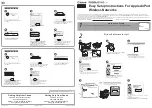
RF Configure Menu
41
Configuring the Wireless Access Point
Network Authentication
The wireless AP offers a variety of authentication methods to protect the net-
work. The succeeding table lists network authentication methods.
WMM Support
Enable or disable support for Wireless Multimedia (WMM), a sub-
set of the 802.11e standard that allows wireless traffic to have a
range of priorities, depending on the kind of data. Time-depen-
dent information, like video or audio, will have a higher priority
than normal traffic. For WMM to function correctly, Wireless cli-
ents must also support WMM.
Max Sta Tx Throughput Specify the maximum transmit frequency of wireless stations.
Max Sta Rx
Throughput
Specify the maximum receive frequency of wireless stations.
VAP Max Station
Number
Specify the maximum number of wireless stations allowed to con-
nect to your virtual access point.
Network
Authentication
Select the authentication method for ensuring network security
Data Encryption
Select a data encryption method for protection wireless packets.
Passphrase
Enter a passphrase to generate a key.
Wireless Client
Security Isolator
If you turn on this function, the associated wireless clients cannot
communicate with one another.
Table 5-8. Security Profile Configuration Submenus (Continued)
Table 5-9. Network Authentication Methods
Item
Description
Open system
Wireless devices (wireless card or wireless bridge) can connect
with the virtual wireless access point without going through any
authentication.To protect interaction packets between the wire-
less devices and the wireless access point you can specify a data
encryption method.
Shared Key
Use this authentication mode together with WEP encryption to
encrypt packets exchanged between the wireless device and the
virtual wireless access point, and also for the wireless access
point to authenticate wireless devices attempting to connect to it.
WPA-PSK,
WPA2-PSK,
WPA-PSK & WPA2-
PSK
No user authentication process, and no requirement of special-
ized authentication server. The user's access control is mainly
through the pre-set shared key encryption for wireless packets.
Encryption for wireless packet is based on the shared key. How-
ever, the shared key is never used to encrypt data packets
directly, but only to ensure the security of underlying key genera-
tion and interaction between the wireless access point and wire-
less terminals. The basic key packet serial number and other
factors generate the final key, which is used to encrypt messages.
Messages are encrypted in the following ways: TKIP (WPA-PSK),
AES (WPA2-PSK), TKIP & AES (WPA-PSK & WPA2-PSK).
These methods are suitable for networks within small and
medium enterprises or homes.
















































